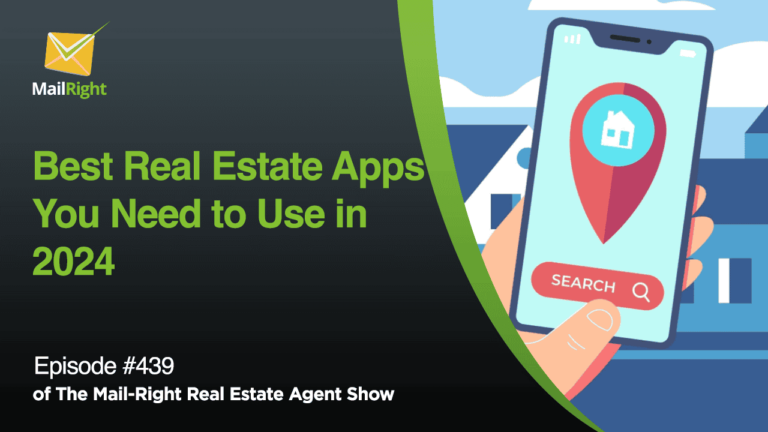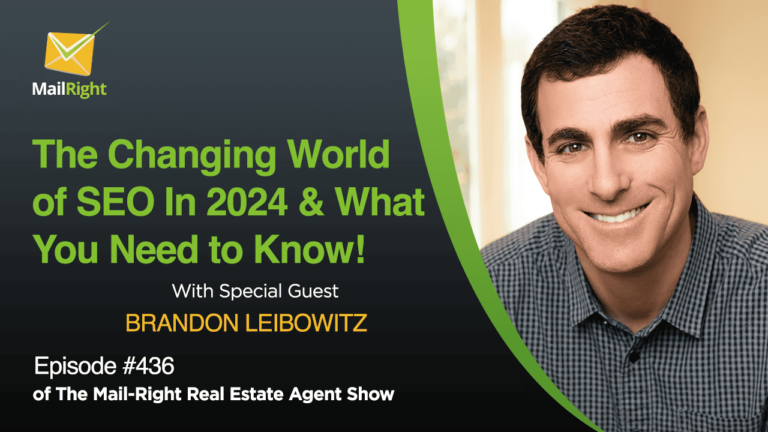In the 434th episode of Mail-Right Show, Robert Newman, and Jonathan Denwood discussed innovative ways to create landing pages that capture attention, nurture leads, and easily drive conversions. Robert Newman is the founder of InboundREM, a content marketing, storytelling-based platform. Meanwhile, Jonathan Denwood is the joint founder of Mail-Right, which builds beautiful websites on WordPress and provides CRM, landing pages, email, text outreach, and more in one great value package. This episode offers agents with useful tips on how to attract clients and get people to provide their information.
A compelling “above the fold” section
When designing an ad, you want to ensure that the first thing people see is eye-catching and interesting, like a big, bold headline or a striking image. That’s what makes people stop and look.
Before, when people bought newspapers from stands, they first saw the headline on the front page. That part of the paper you see first when you open it up is called “above the fold.” It’s the top part that catches your eye right away. Even now, with different devices, this concept still applies. For example, on Facebook, the top part of a page you see first is like the above-the-fold section in a newspaper. It’s where you put the most important things to grab people’s attention quickly. Newspapers have used this idea for a long time—putting big pictures and catchy words at the top so people will immediately notice it.
A strong, catchy headline
Many people believe it needs to be a big change when you change the headline. They think it has to completely change the image and headline to get a different reaction from a Facebook campaign. This idea applies to landing pages and Google Ads, too. People think a big change will make it either succeed or fail, but the truth is that even small changes in words or images can have a significant impact.
If everyone searches for real estate taglines on Google, InboundREM articles have consistently ranked number one or two for four years, which is tough because of how SEO works. It shows that people keep returning to read their content for longer, even when other articles rank high on the page. Why does this matter? Well, being number one in search results is crucial. For example, the top result is about luxury presence with 35 attention-grabbing real estate slogans as taglines. In contrast, InboundREM is number two with just five hundred. That’s a big difference. Titles like Dreams Within Reach, Home Sweet Home, Invest in You, Lux Moving Life, Elevate Your Lifestyle, Live, Love, Home are examples of this.
Creative copy with clear language and benefits
Many brokers make their information boring by using fancy words. Studies show top writers use simple language, like what seventh or eighth-grade kids can understand. Make it interesting in marketing or creating advertisements, but don’t use too fancy words. Simple is good.
If you want to be complex, know your audience well. It’s worth spending time and money to understand them. Knowing your audience helps you create advertisements they’ll like. Either you keep it simple, or you might use legal terms for real estate. It depends on your market.
A transparent and compelling offer
Sometimes, people try to complicate things, especially when making offers or improvements. However, experts in this field know that simple and familiar offers often work best. A good offer is clear and attractive, and it should be simple.
A good deal doesn’t always mean a sale or slashing prices at your store. Try to look for extras you can add to your service that make it appealing without discounting what you offer or hurting your brand. A clear offer is also important. If a person sees one thing promised, but the website says something else, even a little different, they might leave, no matter how good the deal seems.
Transparent means being honest in advertising. So, if you say you will do one thing in your little advertisement, ensure your landing page says it in the first sentence.
Don’t create a lot of hate in your audience by doing anything other than being clear, honest, and compelling. Understand your audience and create something that you think they’ll appreciate.
A Single Call To Action
Having many options and offers on one page isn’t a good idea. It’s better to keep things clear and simple. A landing page should have just one clear offer. A call to action is how people respond to an offer, like clicking a button that says “Get Offer” or “Sign Up Now.” It is effective to have multiple ways to respond to the same offer, like “Click here” or “Click there.” Research shows that having multiple CTAs on a webpage can increase the number of people who take action. CTAs are the last step before you start doing paperwork or similar tasks. They’re usually short, direct, and follow the clear, interesting information you’ve already read. If the information is convincing, people might decide to take action.
High-impact visuals or videos
An image can convey a message quickly. However, there is not much time on a landing page to make the person do something, so it is important to think carefully about the images. The same idea applies to videos. The first frame and the first 20 seconds of a video are crucial. It takes only a short time to catch attention, but images and videos can share information faster than written words.
Building momentum with strong and clear text and an open offer is important when hitting a landing page. You should ask first the visitor if they want to talk now with a button like “Talk to me” or “Meet me.” If they are not ready, say something like, provide a video with more information, and place it a bit lower on the page. After the video, let them know there is more great information below it. This way, people keep reading and watching as they go down the page.
Provide Social Proof
If a video is available for social proof, that is excellent. If not, try to take a picture of the person and link to their website or social media account to show they are real. Prove they exist with testimonials or other proof. People today are very skeptical, and social media has made this worse. Provide as much social proof as possible, but ensure it is real.
Social proof happens when many people have already used a service and say good things about it, making others want to use it, too. The service process has many parts. If people comment about all these parts, it shows social proof.
For example:
- What happens when there is a problem?
- What happens when signing up?
- What happens after using the service for a long time?
Different parts of a service are important. Imagine using a plumber for ten years who fixes four problems. If the plumber does well three times but makes a big mistake on the fourth, that last review is critical. Social proof shows how good a service is. This is important for people when they decide to use the service. On a landing page, go to the call to action.
People need more time to be ready, and social proof is their last and final tool. It is very important and can make someone decide. Make sure to show a lot of social proof. For example, use a video of someone talking about the service. Then, ask for a commitment again. Ask people to sign up, call now, or schedule a call. Offer to show case studies and other information.
Final Thoughts
Remember that landing page success depends on the power of the initial tagline. The goal is to compel someone to read more because converting landing pages is often a very long process. Usually, there is text-based content, followed by a video or an infographic, social proof, and more content in between. Then, there is a form at the bottom that often guarantees language.
Creating a converting landing page is a big project but worth it. A strong landing page can change your entire career. Despite what some might say, a landing page is not just a contact form, although it can be used as one because people land there.





